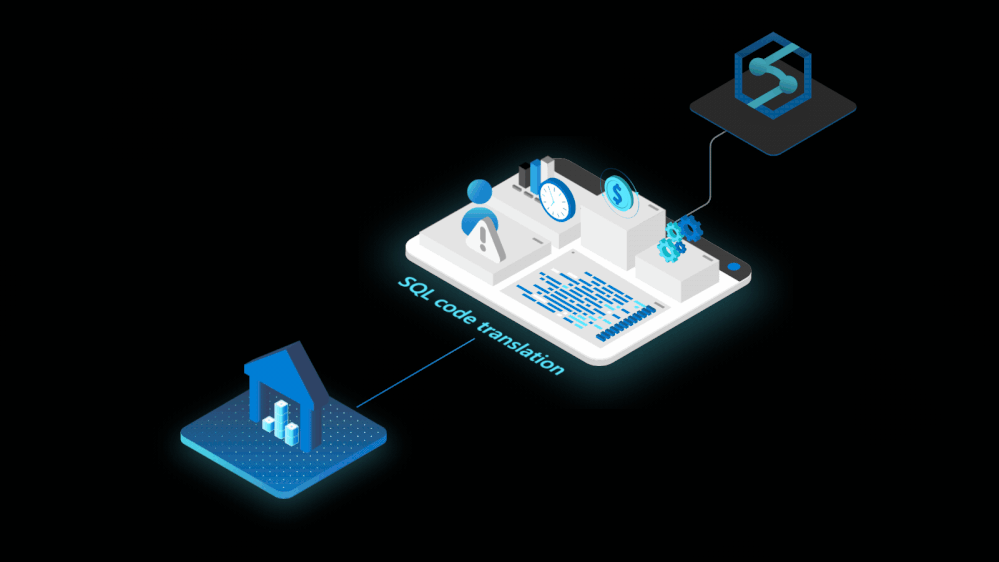
This week, the virtual conference of Microsoft Ignite 2021 made several announcements about new products and services.
Many companies are currently focusing their digital strategy on the implementation of data cloud solutions (PaaS). Microsoft stands out for its ability to innovate and produce innovative solutions, thus positioning itself once again among the leaders in Cloud AI and BI platforms.
In this article, MDW, which is specialized in Microsoft’s Data, AI, and Power Platform solutions, summarizes and analyzes the major announcements made in these areas during Microsoft Ignite 2021.
Key note: Sovereign data and Ambient intelligence

After IDC predicted that the world’s data will grow to 175 zettabytes by 2025, Microsoft has once again been crowned as the absolute leader in analytics and BI platforms. Many specialists and customers were impatient to hear about the strategy and long-term vision of the digital giant in this field.
According to Microsoft CEO Satya Nadella, data will be more private and more sovereign. Data governance and providence will take on new importance. MDW’s analysis of this message is that the efforts made by companies to create solid platforms for data traceability and governance will allow them to both respond to global regulations and know the origin of every piece of data. This will occur in a context where data are increasingly becoming monetizable. In terms of confidentiality, the creation of new personalized AI for each company’s clients must preserve and respect privacy. Regarding business added value, data-driven solutions will bring logic to businessesthrough recurrent and automated learning based on company data. This will improve business processes and productivity systems.
Finally, concerning artificial intelligence, the focus will be more on increasing human capacities (decision making, predictive analysis, human preferences, etc.) than on the automation of existing tasks.
Accelerating edge AI solutions
Microsoft is taking a step forward in IoT by setting up powerful collaborations with Intel (also a speaker) among others. It is also proposing new solutions for IoT devices based on Azure IoT Edge for Linux on Windows (EFLOW).
Providing the best of both worlds, some new capabilities presented by Microsoft and Intel use the broadest of AI models and run Linux workloads in Windows IoT. A great example is the new service of live video analytics based on this technology with powerful applications such as Manufacturing, Business Automation, Customer Engagement, and Workplace Safety.
MLOps in action
MLOps is now gaining importance. Over the past 2 years, most companies and data science teams have incorporated MLOps. Saving time with MLOps is now a reality creating accelerators and secure environments for data scientists. During this event, we saw many different industries with different strategies, although there are also common strategies for the next generation of MLOps.
What’s new in cognitive services
This session focused on health care in 2020.
The healthcare portal has new capabilities to respond to healthcare needs such as predefined health bots to help customers detect intents such as symptoms and drugs using container support and visual tools to develop the bot. This is a huge advance in health care.
The form recognizer has also evolved, with templates for ID, receipts, and invoices as well as special healthcare features.
Improved neural voices provide support with more than predefined 100 voices, with the possibility of training custom voices in more than 50 languages.
Pretrained solutions have been developed for new social distancing and safety computer vision such as detecting masks, calculating the number of persons in a zone, or performing spatial analysis.
These are great solutions to help bring people back to the office and increase safety in closed spaces.

What’s new in Azure ML
Important advances have been made in security and governance on Azure Machine Learning Services: VNets, managed identities, and custom RBAC roles such as the data scientist role or data engineer role.
Connection with synapse and spark clusters.
Incorporation of a terminal with notebooks to facilitate git integration and include more shareable ecosystems between notebooks and VS code.
Improved labeling with a new preview feature of image segmentation and ML-assisted labeling.
Improved experiment views of graphs, plots, and experiment details that are shareable between collaborators.
Improved dataset storage to connect a large variety of data sources and incorporate Data Lake 2 for output data sets.
In terms of explainability and fairness, new features and improvements are directly explorable on the portal: feature importance, adding cohorts to explore the model results on the explainability side, sensitive feature detection, and calculating disparity to mitigate unfairness on our ML models.
All these improvements focused on virtual teams working together in a collaborative, secure, and fair environment.
Microsoft Azure Data Platform
Azure Migrate

The central hub of Azure cloud migration services and tools, which is aimed at discovering, assessing, and migrating workloads to the Cloud, makes it easier than ever to access Azure SQL. Azure Migrate offers new capabilities, which are now in preview. Customers can discover and assess their SQL servers and databases for migration to Azure from within the Azure Migrate portal, receive targeted SKU recommendations and obtain the estimated cost to run workloads in Azure. These changes make it easy to understand all the technical and financial aspects of your journey to the Cloud.
Azure Synapse Pathway
One of the major announcements in the data field was the introduction of the Azure Synapse Pathway. This tool allows the automatic migration from legacy or cloud data warehouses like Teradata, Snowflake, Netezza, Redshift, BigQuery, SQL Server, and more to Azure Synapse Analytics.
With just a couple of clicks, Azure Synapse Pathway scans your source systems and automatically translates your existing scripts to T-SQL. What used to take weeks or months can now be accomplished in a few minutes, thus significantly reducing migration costs.

Azure Purview
A few important updates have been announced for Azure Purview, the new unified data governance service. Now available in preview, with Data Map, Azure Purview can automatically scan and classify AWS Simple Storage Services (S3), SAP ECC, SAP S4/HANA, and Oracle on-premises database. These data can now be discovered across the organization.
Azure Purview’s ability to scan Azure Synapse Analytics workspaces is now also available in preview. With this update, customers can discover and govern data across their serverless and dedicated SQL pools in Azure Synapse workspaces. This expands on Azure Purview’s existing tools, enabling customers to scan data across various sources via out-of-the-box connectors in the Data Map.
Synapse users can now natively discover data with the Purview-powered search within their Synapse workspaces, breaking down operation silos more effectively than ever before.

Cosmos DB
There are four new updates for Cosmos DB:
Azure Synapse Link for Azure Cosmos DB is now GA, which allows cloud-native and near-real-time analytics to be run over the NoSQL data in Azure Cosmos DB, including MongoDB.
Mongo v4.0 server support in Azure Cosmos DB API for Mongo DB is now GA.
Azure Cosmos DB Continuous Backup and Point-in-Time are available in preview to provide backups, recover, and restore data from any point within the past 30 days.
Cosmos DB role-based access control (in preview) allows enhanced security for data in Azure.
Azure Managed Instance for Apache Cassandra
This new semi-managed service is now available in preview. This service will enable organizations to run more of their Cassandra NoSQL data on Azure, thus removing the need for database administrators and developers to manage infrastructure or manage and update their version of Cassandra.
Azure Cache for Redis Enterprise Tiers
Azure Cache for Redis is an open-source in-memory datastore that is used as a database, cache, and message broker. It provides a fast and managed caching layer that can help enable an app’s architecture to handle thousands of simultaneous users. This feature is now generally available with up to 99.999% availability as well as search and time-series ability.
Microsoft Power Platform

Dataverse
Microsoft has increased the capacity of Dataverse for Teams to allow more Enterprise customers to adopt Dataverse with a higher limit and encourage organizations to use prevision Dataverse.
Application lifecycle management for Dataverse will soon be supported to allow people to move their application from different environments and help them to add some structure to their application life cycle process.
Collaboration

Bringing Power BI into Teams enables individuals to collaborate more effectively and bring data into more decision-making processes. Consequently, this enables organizations to distribute data to everyone.
Advantages:
Effortlessly share documents and insights using Power BI in Teams.
Easily find data via the dataset tab, where the entire accessible dataset is listed and searchable.
Access details about the dataset and the origin of the data using the lineage view.
Investigate without even leaving Teams.
Power BI: Several figures on its adoption by companies
Gartner positioned Power BI as the undisputed leader in data visualization tools, although it was still difficult to gain an idea about the adoption of the tool across the globe without the publisher’s figures. Microsoft has just announced the impressive figure of 260,000 companies that regularly use the tool.
Launching of Power BI Premium Gen 2
Microsoft recently announced the launch of Power BI Premium Gen 2.
It has a new and improved set of feature and architectural updates, including the following:
Ability to license Premium Per User available on April 2 for $20/User/Month.
Enhanced performance on any capacity size at any time: analytics operations will run up to 16 times faster.
Auto scale providing the ability to automatically add v-core at any time for 24 hours. V-cores are automatically removed when idle time is detected. Additional v-cores will be charged to your Azure subscription on a pay-as-you-go basis.

Power BI data as an Excel data type
Authors of Power BI data models can now mark tables in the Power BI dataset to be shown in Excel’s data type gallery. Excel users can link individual cells to a row in a Power BI dataset through search experiences by selecting a specific data type or searching across data types published from certified datasets. By curating data types in certified datasets, organizations can ensure that Excel users see official corporate data first, which will help in authoritative decision-making.

Power Automate desktop

This year, Microsoft is encouraging everybody to use Power Platform.
What does this mean? You will be able to automate everyday tasks (that you probably hate doing) and free up time for higher-value work at no additional cost. Power Automate desktop will be included with Windows 10: you will be able to do personal Robotic Process Automation with your Windows license. From March 2, it can be downloaded for free. What can you do with this tool? Automate tasks: from simple data transfer to complex business workflows. Everything with no-code capabilities.
New Governance controls - Power Platform
Microsoft also announced some new governance controls with the Power Platform:
Tenant isolation: manage which other AAD tenants can connect to and integrate with your environment and your organization.
Endpoint filtering for data loss prevention policies: restrict connectors from particular endpoints based on the IP address or fully qualified domain name.
Filtering at the connector action level: choose which actions can be used or blocked instead of blocking the entire connector. For example, you can enable “read” but disable “write” ones.

Power Fx
This event also introduced the newest member of the Power Platform family: Power Fx. This is Microsoft’s open-source language for low-code programming based on Microsoft Excel. You can use familiar formulas and syntax in your own developer projects, whether inside or outside the Power Platform. Microsoft’s planning roadmap aims to expand the use of this language in the future by unifying this language across the Power Platform: Microsoft Dataverse, Microsoft Power Automate, and Microsoft Power Virtual Agents.


Additionally, Microsoft announced the GA of Direct Query for Dataverse inside Power BI. This provides real-time data views inside Power BI when using Dataverse.
